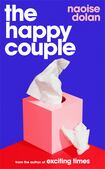
If Dublin writer Naoise Dolan’s 2020 debut, Exciting Times, was a 21st-century remix of an Edith Wharton novel, her much-anticipated second novel, The Happy Couple, is surely Dolan’s Shakespeare mash-up – A Midsummer Night’s Dream rewritten for Gen Z.
Three years after Exciting Times dazzled its way through the early days of lockdown as one of the brightest, cleverest and funniest debuts of the year, Dolan has followed up with a will-they won’t-they story about twentysomethings Celine and Luke, who are engaged but whose skeletons have escaped from the closet and are dressed up as bridesmaids and groomsmen.
Where Exciting Times dealt with a love triangle, The Happy Couple is more of a love hexagon, with all of the added complications.
Celine is a professional pianist who reserves her heart for music. People and emotions come second. She wears gloves to protect her hands and visualises all 88 keys of the piano in her head so she can “play” a piece wherever she is. As the book opens, Celine and Luke seem to decide to get married as a result of a bout of intellectual brinkmanship that ends in stalemate. The story then charts the year leading up to the wedding day as the skeletons dance the hokey pokey in between.
I’m not ready to let Bridget Jones go just yet. She has been a constant comfort to me and so many women I know
‘Irish teenagers are so innocent. Where I’m from we learn not to be naive’
Oesophageal cancer: ‘I was fine, there was nothing wrong with me’
Doireann Garrihy restores some celeb lustre to troubled 2FM with larky verve
The story is told from the different perspectives of a large ensemble cast: Celine and Luke; Celine’s sister Phoebe; Luke’s ex-boyfriend Archie; and Luke’s old friend and ex Vivian. But Dolan doesn’t limit herself, moving fluidly through the points of view of more peripheral characters too. This is initially jarring but the effect eases quickly for the reader and Dolan creates distinctive voices that differentiate her characters.
[ Naoise Dolan: ‘Gay is a fun button to press. God should push it more often’Opens in new window ]
One of the most impressive aspects of Dolan’s debut was the strength and confidence of the writing and The Happy Couple exhibits many of those elements, including the clever quips and funny one-liners, which are almost Chandleresque at times: “Luke looked like he hadn’t slept in forty years, including the eleven that he hadn’t been alive for.” There is much humour in Dolan’s arch observations of Anglo-Irish relations. But I miss the linguistic showmanship Dolan brought to her debut, the acrobatic revelry in language that was so exciting but seems to have been reined in a little here. The intricate dialogue also seems to trip up the rhythm of the story at times rather than making it flow.
But these feel like peevish complaints, a bit like asking a child who has scored 97 per cent on a test what happened to the other 3 per cent. The overall experience of reading this novel is one of great pleasure and enjoyment. Initially, I read it in one greedy gulp, and then a second time more slowly, and beneath the lighthearted high-jinks runs the cooler seam of Dolan’s examination of the concept of monogamy and the institution of marriage as it exists in the context of modern sexuality, not to mention the hypocrisy of the church wedding still popular with a secularised young generation. At one point Archie says, “Can’t you see it’s a cop-out? It happens to be a woman Luke’s marrying, so he gets his Catholic church and the priest gives his blessing and nobody cops that Luke might just as easily have married a man.” These questions vibrate through the whole novel, like sonar under the surface of the storyline.
Dolan is intent on showing her reader a good time, which has made her popular, while her seriousness of intellect brings a satisfying depth and challenge to the reader. There is a scene early on in The Happy Couple, where she writes of the dynamic between Celine and her then-girlfriend Maria, both lovers and rivals as professional pianists. “Maria seemed unable to shake her own suspicion that being popular made her worse,” writes Dolan. It’s a sentiment that could be easily transferred on to how we view literature. It’s a tricky tightrope to walk but Dolan does it with admirable insouciance and style. Where Dolan’s peers can appear all too concerned with the kind of restraint that brings prestige, Dolan allows herself the courageous step of freedom to roam as a writer, which always makes for a more interesting reading experience.
I think Dolan has yet to meet the perfect plot for her delicious writing, but I have no doubt that she will. And while we’re waiting for that, she will keep us gloriously entertained. With The Happy Couple, she has easily done away with any doubters of her spectacular talent while giving us something as light and pleasing and elegant as a French macaron. It’s definitely worth the sugar crash.











